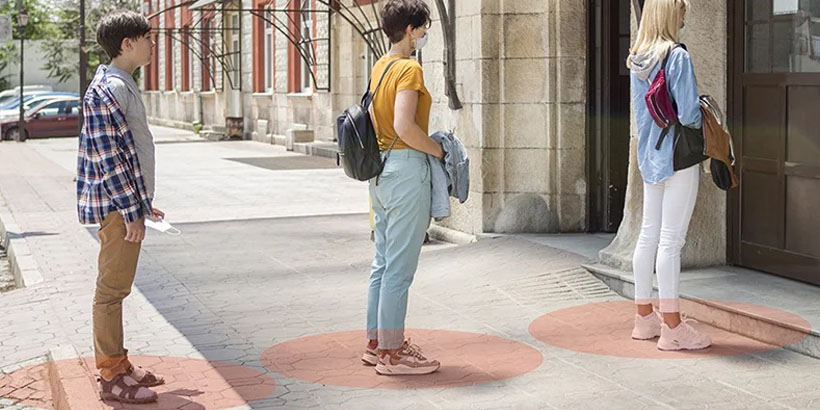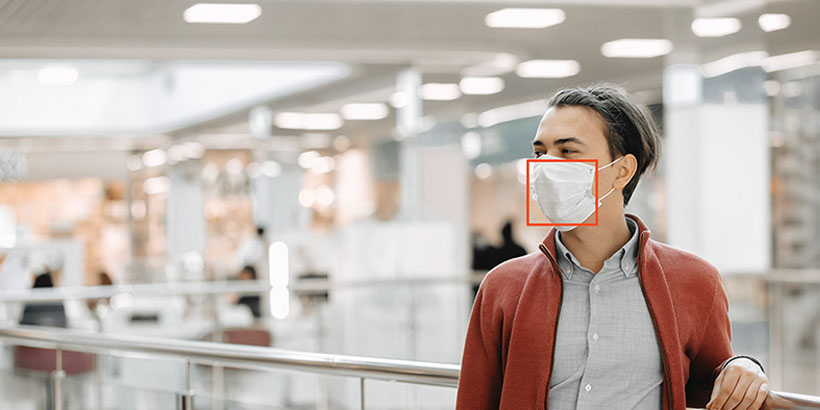The challenge of creating COVID-Secure sites is one which must be met by a significant number of businesses and organisations if they are to operate during what is often referred to as the ‘New Normal’. Not only must sites ensure they meet local regulations in order to engage in business, but they must be ready to adapt to future changes with minimal notice.

Because so little is known about the pandemic and the ways in which transmission of the virus can impact on people, advice is being driven by current experience, which makes it increasingly difficult for businesses and organisation to plan for the short-term and long-term future. Regulations are adapted as more is learned about infection patterns, and as such any investments made must be in flexible smart systems to address the evolving needs.
Despite the changing nature of managing workplaces with regard to COVID-19, there are some restrictions which have remained constant. For example, social distancing has been proven to reduce the risk of virus transmission. Indeed, nearly every regulation and Government-issued advisory across the globe has social distancing at its heart. COVID-19 is predominantly spread through exhaled droplets, and maintaining a distance between people ensures the risk is minimised.
Another constant requirement in the creation of COVID-Secure spaces is the prevention of people with symptoms entering a shared or public space. Most COVID-Secure policies rely on those with symptoms notifying others and implementing self-isolation for a specified period. However, there remains some concern over individuals who might be asymptomatic or unaware of their condition, and many people will be uncertain as to whether certain symptoms are relevant to COVID-19 infections.
Monitoring of body temperature has proven to be a key element in the assessment of risk of infection, although in itself it is not a perfect indicator. Some people with COVID-19 infection will not display an elevated temperature, just as many people with an elevated temperature will not be infected with COVID-19. However, as an indicator, it can be used to advise those with an elevated body temperature to make use of medical COVID-19 testing.
The arguments in favour of extending the requirements for the use of face coverings are increasing, with the World Health Organisation advising their use in public or shared spaces. Because droplets are a key method of transmission, face coverings are a positive step in terms of protecting others from potential infection if the individual wearing the mask has the virus. Increasingly, regulations make the wearing of face coverings in certain environments compulsory, and many businesses and organisations are introducing policies regarding face coverings to protect their staff.
To date, the management of social distancing, monitoring for the correct use of face coverings and checking temperatures of staff and visitors have, in the majority of cases, been manual tasks carried out by staff. This approach is not only inefficient and takes staff away from more essential roles, but can create an elevated risk for front-line personnel at a time when end users are having to adhere to a duty of care.
However, these tasks can be made more efficient, and can also be automated, with the use of a smart surveillance system. By implementing video analytics through a flexible and robust VMS, it is possible to increase the COVID-Secure protection for a site while also enjoying enhanced security and business efficiency benefits.
Deploying analytics
There are several ways in which intelligent video analytics can add benefits when designing a solution for COVID-Secure sites. For example, video analytics can be used to help implement and manage social distancing, not only giving accurate real-time flow analysis, such as the number of people entering and leaving an area, but also with regard to density within a space, identifying those who are closer than the required distance.
Additionally, video analytics has a role to play in monitoring whether people are wearing face coverings in designated areas. This can prompt notifications to staff, who can then decide if any further actions are required.
Finally, through integrations with appropriate thermal imaging devices, it is possible to measure the body temperature of people as they pass through an area. Elevated temperature can be a symptom of COVID infection. However, the identification of individuals with high temperatures can be used as an indication that further steps, such as testing, are required.
It is critical that consideration is given to how the video analytics will be implemented. Unless the provider of solutions has considered the ‘real world’ application of these technologies, users are likely to struggle to create reliable and consistent results. For example, with regard to social distancing, site limitations may mean individuals have no option but to be in closer proximity than the specified distance in certain situations, such as if they need to pass through a restricted space. It is therefore essential a defined time window for exceptions can be set, so the system will not generate nuisance alerts.
The essential difference between good video analytic implementations and bad ones is flexibility. This doesn’t mean you should look for smart video solutions which boast the largest number of variables, as these will often be complicated and use bloated code. Instead look for solutions which include the necessary options to deliver the right level of performance.
Sticking with the example of social distancing, there needs to be flexibility to adjust the distance and the time duration after which two or more people in close proximity qualify as an exception requiring action. With modern video analytics, there will not be a need to define people if a leading solution which uses AI-enabled object classification is specified. Systems such as CathexisVision 2020 use advanced algorithms to differentiate between people, vehicles and animals. Therefore, the monitoring of social distancing will only be carried out if there are people in the viewed scene.
A Smarter Option
CathexisVision 2020 is an advanced, flexible and cost-effective video management solution which delivers the highest levels of security, safety and added value. The award-winning software provides a wide range of advanced features such as smart searching, object classification, alarm management, access rights, viewing and control via mobile devices, failover and cybersecurity, advanced recording and storage, etc..
The latest version also includes functions specifically designed to help implement a COVID-Secure site. This includes management of social distancing, detection of face masks, and integration with thermal imaging cameras for temperature monitoring.
As already mentioned, social distancing remains a key step in preventing the transmission of COVID-19. For many businesses and organisations, it remains a significant challenge. By utilising the functionality in CathexisVision 2020, the software tracks activity in protected spaces using people proximity analytics, automatically identifying situations where people are closer than the stipulated distance.
To ensure accurate performance, the user can specify the minimum distance between people, for example two metres. They can also configure a period of persistence, set in seconds, to define a duration after which a lack of distancing becomes an notifiable issue. This means the system will not generate an alert if people are closer than the minimum distance for a short time. If individuals pass each other briefly, and the persistence is set as a greater length of time, there will be no alert. However, if they remain in close proximity for longer than the persistence duration, an alert is generated.
 Mask detection technology can automatically detect whether someone is wearing a mask or not, and displays real-time, informative overlays and alerts. The overlays are fully customisable and can therefore include instructions for operators.
Mask detection technology can automatically detect whether someone is wearing a mask or not, and displays real-time, informative overlays and alerts. The overlays are fully customisable and can therefore include instructions for operators.
The mask detection technology has a high degree of flexibility to ensure accuracy. In some applications it might be critical to identify if someone entering a space is wearing a mask. This can be used to alert an operator if anyone is not wearing an appropriate facial covering. It is also possible for the technology to be used for smart detection and analysis. This can effectively monitor a person over a period of time, ensuring the mask is not removed while they are in a specified area.
Options include the ability to specify face sizes, eliminating potential problems with the detection algorithm picking up faces in the distance which could result in inaccurate results or nuisance activations.
The measurement of body temperature is a useful metric when assessing risk of infection, although it must be accepted some people who might be infectious will not display an elevated temperature, while others with a high temperature might be free from infection. However, when used appropriately, it can add another layer to infection control.
 A growing number of thermal cameras have the capability to report detected temperatures from targeted objects, although not all models have this function so it is critical to ensure selected imagers are suitable. Cathexis has worked closely with leading manufacturers to allow the integration of temperature alert capabilities with the CathexisVision 2020 video management solution.
A growing number of thermal cameras have the capability to report detected temperatures from targeted objects, although not all models have this function so it is critical to ensure selected imagers are suitable. Cathexis has worked closely with leading manufacturers to allow the integration of temperature alert capabilities with the CathexisVision 2020 video management solution.
It is worth considering that many manufacturers offer hybrid video/thermal devices, which use two camera modules. These are designed to give the same field of view over a specified distance. However, if used to view foreground objects nearer to the camera, as will be the case with temperature analysis, the fields of view don’t always match. This is an important issue as many systems use video to detect the presence of a face and themography to measure temperature. The different fields of view can create problems, but CathexisVision 2020 uses parallax correction to remove any problems, which ensures higher levels of accuracy.
The addition of temperature screening delivers the ability to provide a visual representation of body temperature, creating notifications if it exceeds configured thresholds. The real-time alerts can be driven by fully customisable temperature zones for safe, caution and danger notifications.
Temperature measurement methods are adaptable, allowing the system to use the highest temperature recorded on a face, or the average temperature. The link between temperature screening and the Cathexis Face Detection algorithm enables the temperature of specific facial points to be measured, such as eyes, nose, mouth and tear ducts. In certain situations, such as if people are wearing glasses, measuring the temperature of the eye area alone can be problematic.
To enhance accuracy, temperatures can be measured over a period of time, or a certain number of video frames, to ensure consistency in the results. The algorithms also detect if attempts are made to evade measurement.
In summary
Businesses and organisations currently face an unprecedented challenge dealing with the return to work following the pandemic. By utilising a smart and efficient video management solution such as CathexisVision 2020, users can enjoy a range of benefits which add value, increase efficiency and make the workplace a safer environment for all concerned.

